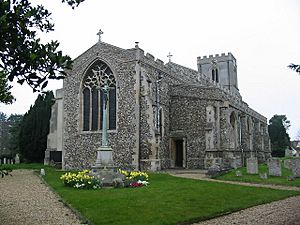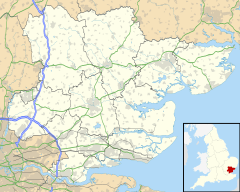Great Chesterford facts for kids
Quick facts for kids Great Chesterford |
|
|---|---|
 All Saints' Church |
|
| Population | 1,776 (2021) |
| OS grid reference | TL5143 |
| • London | 40 mi (64 km) S |
| Civil parish |
|
| District |
|
| Shire county | |
| Region | |
| Country | England |
| Sovereign state | United Kingdom |
| Post town | SAFFRON WALDEN |
| Postcode district | CB10 |
| Dialling code | 01799 |
| Police | Essex |
| Fire | Essex |
| Ambulance | East of England |
| EU Parliament | East of England |
| UK Parliament |
|
Great Chesterford is a village in Essex, England. It is part of the Uttlesford district. The village is about 13 miles (21 km) north of Bishop's Stortford. It is also 10 miles (16 km) south of Cambridge. Great Chesterford is about 25 miles (40 km) northwest of Chelmsford, which is the county town of Essex.
Two long-distance walking and cycling routes pass through the village. These are the Icknield Way Path and the Icknield Way Trail. These routes stretch for 110 miles (180 km) between Buckinghamshire and Suffolk.
Contents
History of Great Chesterford
Great Chesterford is a very old village. It has many historic buildings. It sits by the River Cam, also known as the Granta. The village is right on the border of Essex and Cambridgeshire.
Ancient Times and Roman Life
People have lived in the area around Great Chesterford for many centuries. Archaeologists have found many interesting things here. These include Bronze Age pots and ancient jewelry. Many Roman items have also been found. You can see some of these finds in museums in Saffron Walden and Cambridge.
Around the 1st century AD, the Romans built a settlement near the river. This was an important stop on the route between London, Cambridge, and Newmarket. The Romans built many structures, including a tax office. They also built a temple, which was found east of the town. In the 4th century, the Romans built a wall around the town. Parts of this wall have been found, and its exact path is known. It even passed under what is now the Crown House Hotel.
From Saxons to Medieval Times
After the Romans left, people likely continued to live in the area. Evidence of Saxon life has been found in burial sites. The village developed in its current center during the Middle Ages. The name Chesterford was first written down in 1004. It was also mentioned in the Domesday Book in 1086. In 1459, a local church leader, Thomas Hyll, started a charity. This charity helped people in need in the village, and it still exists today.
In 1514, a school was officially allowed to open. By 1540, Great Chesterford was mainly a farming community. During medieval times, Great Chesterford became an important town. It had a weekly market, which was later confirmed by King Charles I in 1634. There was also a fair held on St John the Baptist’s Day.
The Coaching Inn and Racing
By 1635, Great Chesterford became an important stop for people traveling to the Newmarket Races. King Charles I often used the village. People would gather to watch him. There were sometimes complaints about noise from the Crown House. This building was a coaching inn back then. These complaints led to a ban on Sunday racing. Newmarket Races followed this ban until recently.
The Congregational church on Carmel Street was built in 1841. The Primary School, now called Great Chesterford Church of England Primary Academy, was built between 1845 and 1849.
How the Village is Run
Great Chesterford is part of the Chesterfords electoral ward. An electoral ward is an area that elects local representatives. In 2011, the total population of this ward was 1,709 people.
Getting Around Great Chesterford
Great Chesterford has public transport options. The Great Chesterford railway station was built around 1845. It was designed by Sancton Wood and Francis Thompson. There is also a Stagecoach East bus service. The village is less than 1 mile (1.6 km) from Junction 9A of the M11 motorway. This is where the motorway meets the A11 road to Norwich.
Famous People
The well-known writer and academic Germaine Greer lived in Great Chesterford until 2018.
See also
 In Spanish: Great Chesterford para niños
In Spanish: Great Chesterford para niños


